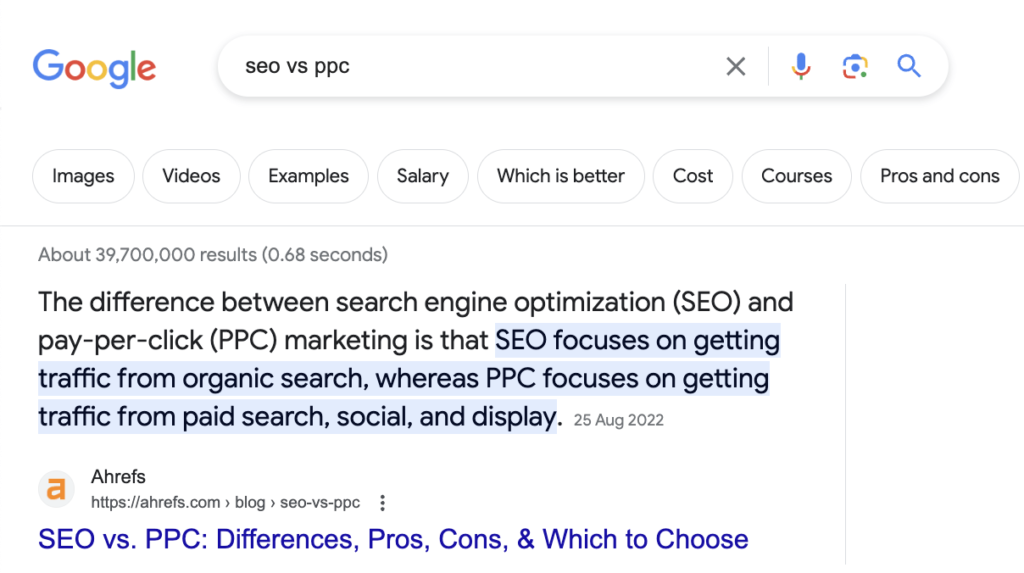In the ever-evolving landscape of search engine optimization (SEO), achieving a featured snippet, often referred to as “position zero,” can provide a significant boost to your website’s visibility and click-through rate (CTR). Featured snippets are concise answers displayed at the top of Google’s search results, above the standard organic listings. They are highly coveted because they attract more attention and traffic. This guide will delve into strategies for optimizing your content to secure these prime positions.

Understanding Featured Snippets
Featured snippets come in various formats, including paragraphs, lists, tables, and videos. Understanding the type of snippet Google might display for your target keywords is crucial for optimization.
Types of Featured Snippets:
- Paragraph Snippets: These provide a brief answer or definition.
- List Snippets: These present information in a bullet or numbered list.
- Table Snippets: These display data in a table format.
- Video Snippets: These feature a video that answers the query.
1. Conduct Thorough Keyword Research
Keyword research is the cornerstone of any SEO strategy, and it’s especially critical for featured snippets. Identify questions and queries your target audience is asking. Tools like AnswerThePublic, SEMrush, and Ahrefs can help uncover common questions related to your niche.
Tips for Keyword Research:
- Focus on long-tail keywords and question-based queries.
- Analyze the current featured snippets for your target keywords to understand the format and content Google favors.
- Use tools like Google’s “People Also Ask” to find related queries.

2. Structure Your Content for Snippets
The way you structure your content plays a significant role in capturing featured snippets. Ensure your content is well-organized and easy to read, with clear headings and concise answers.
Content Structuring Tips:
- Use Headings (H2, H3, etc.): Break down your content with relevant headings to make it scannable.
- Provide Clear Answers: Answer the query directly within the first 100 words of your content.
- Use Lists and Tables: Format information as lists or tables where appropriate, as these are commonly featured.
3. Optimize for Paragraph Snippets
Paragraph snippets typically feature a concise answer or definition. To optimize for these, ensure your content includes clear and direct answers to potential questions.
Example Strategy:
- Question: What is SEO?
- Answer: SEO, or Search Engine Optimization, is enhancing a website to increase its visibility in search engine results.
4. Target List Snippets
List snippets are perfect for “how-to” guides, steps, or ranked lists. Break down the information into clear, ordered steps or bullet points.
Example Strategy:
- Question: How to optimize a website for SEO?
- Answer:
- Conduct keyword research.
- Optimize on-page elements.
- Build high-quality backlinks.
- Improve site speed.
- Ensure mobile-friendliness.
5. Aim for Table Snippets
Table snippets are ideal for displaying data or comparisons. Use HTML tables to organize information clearly.
Example Strategy:
- Question: SEO tools comparison.
- Answer:
| Tool | Features | Pricing |
|---|---|---|
| SEMrush | Keyword research, site audit | Starts at $99/month |
| Ahrefs | Backlink analysis, keyword research | Starts at $99/month |
| Moz | SEO tracking, site audit | Starts at $99/month |
6. Leverage Video Snippets
Video content is becoming increasingly popular, and Google often features videos for “how-to” and tutorial queries. Optimize your videos by providing clear titles, and descriptions, and including a transcript.
Tips for Video Optimization:
- Use descriptive titles and include the target keyword.
- Write detailed descriptions that summarize the video content.
- Provide a transcript to enhance keyword relevance.

7. Enhance On-Page SEO
Ensure your content is fully optimized for SEO to increase its chances of being selected for a featured snippet. This includes using target keywords in strategic places and optimizing meta tags.
On-Page SEO Tips:
- Title Tags and Meta Descriptions: Include the target keyword and make them compelling.
- Header Tags: Use H1, H2, and H3 tags to organize content.
- Alt Text for Images: Describe images with relevant keywords.
- Internal Linking: Link to related content on your site to improve navigation and context.
8. Improve Page Speed and Mobile Usability
Google prioritizes fast-loading and mobile-friendly pages. Ensure your site is optimized for speed and usability across all devices.
Tips for Page Speed and Mobile Optimization:
- Compress Images: Use tools like TinyPNG to reduce image file sizes.
- Use a Content Delivery Network (CDN): Distribute your content globally to reduce load times.
- Mobile-Friendly Design: Use responsive design to ensure your site adapts to all screen sizes.
Conclusion
Securing a featured snippet can significantly enhance your website’s visibility and drive more organic traffic. By understanding the different types of snippets and optimizing your content accordingly, you can increase your chances of achieving that coveted position zero. Remember, SEO is an ongoing process, and staying updated with the latest trends and best practices is crucial for sustained success.